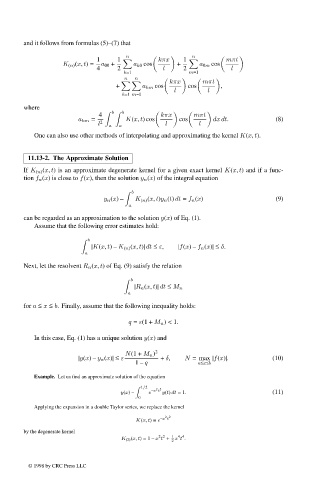Page 596 - Handbook Of Integral Equations
P. 596
and it follows from formulas (5)–(7) that
n n
1 1 kπx 1 mπt
K (n) (x, t)= a 00 + a k0 cos + a 0m cos
4 2 l 2 l
k=1 m=1
n n
kπx mπt
+ a km cos cos ,
l l
k=1 m=1
where
b b
4 kπx mπt
a km = K(x, t) cos cos dx dt. (8)
l 2 l l
a a
One can also use other methods of interpolating and approximating the kernel K(x, t).
11.13-2. The Approximate Solution
If K (n) (x, t) is an approximate degenerate kernel for a given exact kernel K(x, t) and if a func-
tion f n (x) is close to f(x), then the solution y n (x) of the integral equation
b
y n (x) – K (n) (x, t)y n (t) dt = f n (x) (9)
a
can be regarded as an approximation to the solution y(x) of Eq. (1).
Assume that the following error estimates hold:
b
|K(x, t) – K (n) (x, t)| dt ≤ ε, |f(x) – f n (x)|≤ δ.
a
Next, let the resolvent R n (x, t) of Eq. (9) satisfy the relation
b
|R n (x, t)| dt ≤ M n
a
for a ≤ x ≤ b. Finally, assume that the following inequality holds:
q = ε(1 + M n )<1.
In this case, Eq. (1) has a unique solution y(x) and
N(1 + M n ) 2
|y(x) – y n (x)|≤ ε + δ, N = max |f(x)|. (10)
1 – q a≤x≤b
Example. Let us find an approximate solution of the equation
1/2
2 2
y(x) – e –x t y(t) dt =1. (11)
0
Applying the expansion in a double Taylor series, we replace the kernel
2 2
K(x, t)= e –x t
by the degenerate kernel
2 2
4 4
K (2) (x, t)=1 – x t + 1 x t .
2
© 1998 by CRC Press LLC
© 1998 by CRC Press LLC
Page 579

